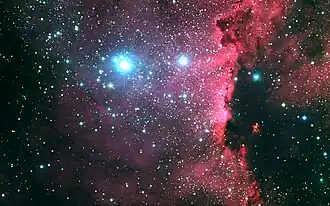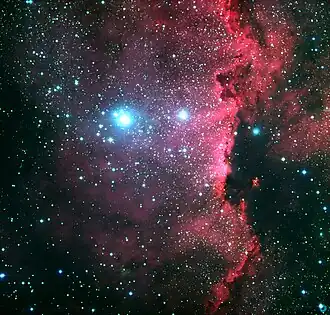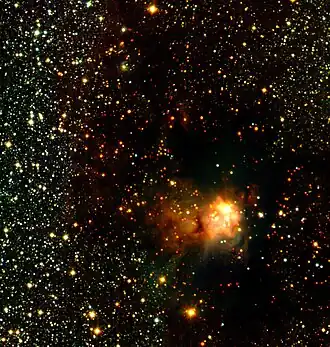RCW 108
| Emission nebula | |
|---|---|
| H II region | |
 RCW 108, as photographed by the Wide Field Imager in 1999 | |
| Observation data: J2000.0 epoch | |
| Right ascension | N/A |
| Declination | N/A |
| Distance | 4,000 ly |
| Constellation | Ara |
| Designations | Rim Nebula, NGC 6188 |
RCW 108, also called the Rim Nebula,[1] is a large star formation in the Milky Way, about 4,000 light years from Earth. RCW 108 is part of the Constellation Ara.[2] is in the process of being destroyed by intense light which radiates from a star inside of NGC 6193. NGC 6188 has an angular extent of 20.0' × 12.0', and has been heavily documented by multiple telescopes, including Chandra and Spitzer.[3]
Gallery
-
 Composite of X-ray data from NASA's Chandra X-ray Observatory (blue) and infrared emission detected by NASA's Spitzer Space Telescope (red and orange)
Composite of X-ray data from NASA's Chandra X-ray Observatory (blue) and infrared emission detected by NASA's Spitzer Space Telescope (red and orange) -
 1999 composite from the Wide Field Imager
1999 composite from the Wide Field Imager -
 Based on approx. 600 individual exposures with the SOFI instrument at the 3.58-m ESO New Technology Telescope
Based on approx. 600 individual exposures with the SOFI instrument at the 3.58-m ESO New Technology Telescope
References
- ^ EOS. "RCW 108: Massive Young Stars Trigger Stellar Birth". NASA Jet Propulsion Laboratory (JPL). Retrieved 2024-03-20.
- ^ [email protected]. "Star-forming region RCW 108 in Ara". www.eso.org. Retrieved 2024-03-20.
- ^ "NGC 6188". spider.seds.org. Retrieved 2024-03-20.